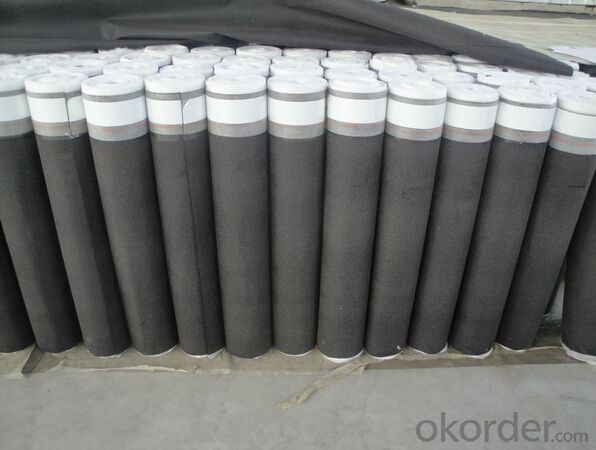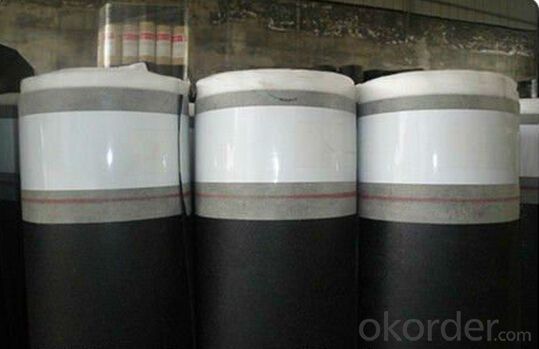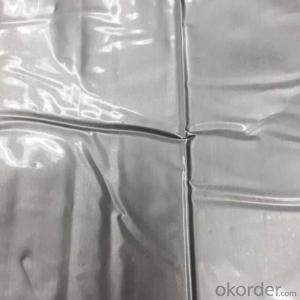Self-adhesion Bitumen Waterproofing Membrane
- Loading Port:
- Qingdao
- Payment Terms:
- TT OR LC
- Min Order Qty:
- 2000 m²
- Supply Capability:
- 60000000 m²/month
OKorder Service Pledge
OKorder Financial Service
You Might Also Like
Specifications:
Introduction Self-adhesion Bitumen Waterproofing Membrane:
SBS(Styrene Butadiene Styrene) /APP (Atactic Polypropylene) modified bitumen membrane is made by saturating the base in bitumen, or thermoplastic elastomer (such as SBS, APP, APAO, APO), reinforced with polyester or fiberglass, finishing the upward face with polythene membrane, fine sands or mineral slates (or grains) or etc.
Specification Self-adhesion Bitumen Waterproofing Membrane:
Thickness | 3mm, 4mm, 5mm |
Width | 1m |
length | 7.5m, 10m, 15m, or on demand |
Base | Polyester or Fiberglass felt |
Surface | PE film, Aluminum foil, Yellow sand, Shale gravel(Schist), colored sand |
Type | could self-adhesive |
Notice | SBS modified bitumen membrane is specially applied in the cold district, APP modified bitumen membrane is more suitable for hot district with high temperature. could be self-adhesive modified bitumen membrane |
Applications Self-adhesion Bitumen Waterproofing Membrane:
-Roof and underground in industrial and civil buildings;
-Bridge, subway, tunnel, swimming pool, etc.
-Waste landfill, sewage plant, irrigation system, etc.
-Self-adhesive Modified Bitumen Waterproof Membrane
-Easy applying and economic on the cost saving
Advantage Self-adhesion Bitumen Waterproofing Membrane:
-Non-solidified, excellent elastic deformation,thus have good noise reducing;
-Easy applying and economic on the cost saving.
-Good performance on waterproof and economic sound damping.
Picture Self-adhesion Bitumen Waterproofing Membrane:

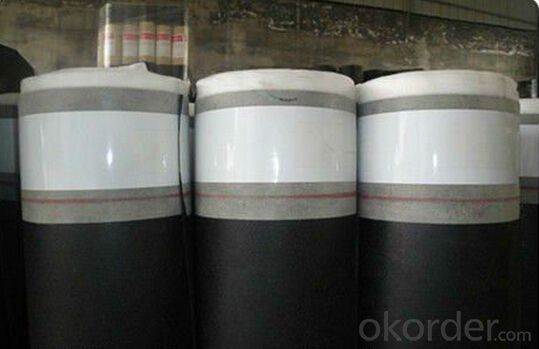




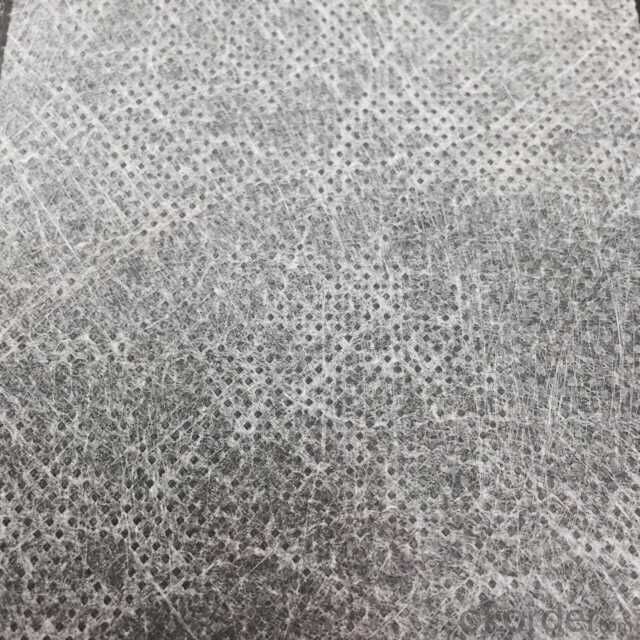




Storage Self-adhesive Ridge Ventilation Membrane for Roofing:
Shelf life is 12 months. Store in a cool and dry place with original packing.
Breathable Waterproof Roof Underlay membrane (PP-PP,S-PP,S-S)
Permeable membrane is polymer modified asphalt based, with surface of high strength polypropylene fiber. Back side coated with self adhesive glue or antiskid sand. Made by special process. With excellent waterproof performance and breathable properties.\
Description | Specification | Width | Length | Thickness | |
Roof underlay | 500g/m2PP—PP | 1000mm | 30m | 0.8mm | |
600g/m2S—PP | 1000mm | 25m | 1.0mm | ||
1500g/m2S—S | 1000mm | 20m | 1.3mm | ||
Roof underlay with adhesive band | 500g/m2PP—PP | 1000mm | 30m | 0.8mm | |
600g/m2S—PP | 1000mm | 25m | 1.0mm | ||
1500g/m2S—S | 1000mm | 20m | 1.3mm | ||
It is used as the underlayment of cement tile, painted pottery watts and asphalt shingle. Also suitable for all kinds of architectural roofing, walls, underground waterproof and damp proof project.
Features:
It has good waterproofing and ageing-resistance function,not flowing at highest temperature and no crack at lowest temperature;
Easy application,no pollution,and long service life etc.
Usage:
It is widely used for industry and civil building --- the waterproof and dampproof of the roofs,basements,toilets etc;and the waterproofing of bridges,parking area,tunnels,reserviors etc.
It is specially suitable to the building waterproofing in cold area and to the buildings of changeable constructions.
Requirements for surroundings
-The base should be dry and clean. Do not work in the rainy or snowy day.
-Do not work under heavy wind(above 5 grade)
-Unsuitable for construction below 0°C
FAQ:
1. What are we supplying?
We are specialized in producing Colorful Asphalt Roof Shingle, SBS/APP modified bitumen waterproof membrane, Self adhesive bitumen waterproof membrane, PVC waterproofing membrane, EPDM rubber roofing membrane, Single Component Polyurethane Waterproof Coating, and Spray Polyurea Waterproof Coating
2. How Many years experience do we have?
We have been exported to more than 20 countries in the past 15 years.
3. How long do we usually reply your request?
We always reply our customer within 24 hours.
- Q: Can a waterproofing membrane be used on precast concrete surfaces?
- Yes, a waterproofing membrane can be used on precast concrete surfaces. Precast concrete surfaces are commonly used in construction for various applications such as walls, floors, and roofs. These surfaces are prone to water penetration, which can cause damage and deterioration over time. To prevent this, a waterproofing membrane can be applied to the precast concrete surface. A waterproofing membrane is a thin layer of material that is designed to prevent the passage of water. It is typically made of materials such as bitumen, rubber, or PVC. The membrane is applied to the surface of the precast concrete and acts as a barrier, preventing water from seeping into the concrete. There are several benefits to using a waterproofing membrane on precast concrete surfaces. Firstly, it helps to extend the lifespan of the precast concrete by protecting it from water damage. Water can cause the concrete to crack, corrode reinforcement, and lead to the growth of mold and mildew. By applying a waterproofing membrane, these issues can be minimized or prevented altogether. Secondly, a waterproofing membrane can improve the overall performance of the precast concrete. By preventing water penetration, the membrane helps to maintain the structural integrity of the concrete. It also helps to maintain a dry and comfortable environment inside buildings by preventing water leakage. Lastly, a waterproofing membrane can provide additional protection against other elements such as chemicals and UV rays. Some membranes are designed to resist chemical exposure, which can be beneficial in industrial or commercial settings. Additionally, certain membranes have UV-resistant properties, which can help to prevent damage caused by prolonged exposure to sunlight. In conclusion, a waterproofing membrane can be used effectively on precast concrete surfaces to prevent water penetration and protect the concrete from damage. It is a cost-effective and efficient solution to ensure the durability and longevity of precast concrete structures.
- Q: Can a waterproofing membrane be installed on a concrete foundation?
- Yes, a waterproofing membrane can be installed on a concrete foundation. Waterproofing membranes are commonly used to protect concrete foundations from water damage and to prevent moisture from seeping into the building. The membrane is applied directly onto the foundation to create a barrier against water penetration.
- Q: Does a waterproofing membrane require any special considerations for installation in seismic zones?
- Yes, a waterproofing membrane does require special considerations for installation in seismic zones. Seismic zones are prone to earthquakes and ground movements, which can cause significant stress and strain on the building structure. When installing a waterproofing membrane in such areas, it is crucial to ensure that it can withstand the potential movements and vibrations caused by seismic activities. Some of the special considerations for installing a waterproofing membrane in seismic zones include: 1. Flexibility: The membrane should have sufficient flexibility to accommodate the movement of the building structure during an earthquake. It should be able to stretch, contract, and withstand dynamic forces without tearing or losing its waterproofing properties. 2. Compatibility: The waterproofing membrane should be compatible with the building materials and systems used in seismic zones. It is important to select a membrane that can bond well with the substrate and other construction components to create a seamless and robust waterproofing system. 3. Reinforcement: In high seismic areas, it is recommended to reinforce the waterproofing membrane with additional layers or reinforcements. This can be done by adding a fabric or mesh layer to enhance the membrane's tensile strength and resistance to tearing caused by seismic movements. 4. Proper installation techniques: The installation of the waterproofing membrane in seismic zones should follow specific guidelines and techniques to ensure its effectiveness. It may involve using specific adhesives, primers, or mechanical fastening systems to secure the membrane properly. 5. Quality control: Regular inspections and quality control measures should be implemented during and after the installation process. This helps to identify any potential issues or deficiencies in the waterproofing system, allowing for prompt repairs or adjustments to be made. By addressing these special considerations, the installation of a waterproofing membrane in seismic zones can help protect the building structure from water intrusion and potential damage caused by earthquakes. Consulting with experienced professionals and following industry standards and guidelines is crucial to ensure a successful installation in these challenging environments.
- Q: Can a waterproofing membrane be used in cold climates?
- Indeed, a waterproofing membrane is suitable for use in cold climates. It is highly advisable to utilize a waterproofing membrane in cold climates to safeguard structures from moisture damage caused by snow, ice, and freezing temperatures. These membranes are engineered to possess flexibility and durability, enabling them to endure extreme temperature fluctuations without experiencing cracks or deterioration. They establish a barrier that thwarts water from permeating the structure, a critical factor in cold climates where water can freeze and expand, resulting in substantial harm to buildings and infrastructure. Additionally, certain waterproofing membranes are specifically formulated to excel in cold weather conditions, offering heightened resistance to freeze-thaw cycles and ensuring long-term protection against water infiltration. Therefore, it is imperative to employ a high-quality waterproofing membrane in cold climates to uphold the integrity and longevity of structures.
- Q: Can a waterproofing membrane be used in areas with extreme temperatures?
- Indeed, in areas with extreme temperatures, it is possible to utilize a waterproofing membrane. Numerous waterproofing membranes are specifically crafted to endure a vast spectrum of temperatures, ranging from scorching hot to freezing cold. These membranes are manufactured using materials that exhibit resistance against cracking, melting, or brittleness when exposed to extreme temperatures. Moreover, certain waterproofing membranes are specially engineered for deployment in regions with extreme temperatures, such as arctic or desert environments. To guarantee efficacy and durability, it is crucial to select a waterproofing membrane that aligns with the specific temperature range of the intended area of use.
- Q: Is a waterproofing membrane resistant to saltwater or salt damage?
- Yes, a waterproofing membrane is typically resistant to saltwater or salt damage. Waterproofing membranes are designed to provide a barrier against water and moisture, and they are commonly used in various applications where exposure to saltwater or salt is expected, such as in marine environments or near coastal areas. These membranes are often made from materials that are specifically formulated to withstand the corrosive effects of saltwater or salt. Additionally, the installation of a waterproofing membrane includes proper preparation and sealing techniques to ensure its resistance to saltwater or salt damage. However, it is important to note that the specific resistance of a waterproofing membrane to saltwater or salt damage may vary depending on the type and quality of the membrane used. Therefore, it is recommended to consult with a professional or manufacturer to ensure the appropriate membrane is selected for the specific application and environment.
- Q: Are waterproofing membranes resistant to chemical spills?
- Yes, waterproofing membranes are typically resistant to chemical spills. These membranes are designed to create a barrier that prevents water and other liquids from penetrating into the underlying structure or substrate. In order to provide this protection, waterproofing membranes are often made from chemically resistant materials, such as synthetic rubber, thermoplastic, or modified bitumen. These materials are chosen for their ability to withstand exposure to a wide range of chemicals, including oils, solvents, acids, and alkalis. However, it is important to note that the specific chemical resistance of a waterproofing membrane may vary depending on the materials used and the manufacturing process. Therefore, it is necessary to consult the manufacturer's guidelines or specifications to ensure that the chosen waterproofing membrane is suitable for the intended chemical environment.
- Q: Is a waterproofing membrane compatible with different types of flooring materials?
- Yes, a waterproofing membrane is compatible with different types of flooring materials. A waterproofing membrane is designed to create a barrier between the subfloor and the flooring material, preventing moisture from seeping through and causing damage. This makes it suitable for use with various flooring types such as laminate, vinyl, tile, and even hardwood. The waterproofing membrane ensures that the flooring material remains protected from water damage, extending its lifespan and maintaining its appearance. However, it is important to note that different types of waterproofing membranes may have specific compatibility requirements, so it is recommended to consult the manufacturer's guidelines to ensure proper installation with the chosen flooring material.
- Q: Can waterproofing membranes be used in wet areas like bathrooms?
- Waterproofing membranes are indeed suitable for wet areas such as bathrooms. It is strongly advised to utilize these membranes in bathroom spaces to prevent water damage and leaks. These membranes are specifically designed to form a barrier against moisture, guaranteeing that water does not infiltrate the bathroom's walls, floors, or other surfaces. By applying a waterproofing membrane, you can effectively safeguard the underlying structure from water damage, mold growth, and other issues caused by extended exposure to moisture. This is particularly crucial in wet areas like bathrooms where water is consistently present. Waterproofing membranes can be found in various forms, including sheet membranes, liquid membranes, and even pre-formed shower trays. They can be applied to walls, floors, shower enclosures, and other surfaces to create a tight seal against water. It is essential to correctly install and maintain the waterproofing membrane according to the manufacturer's guidelines to ensure its efficacy and durability. Therefore, if you are contemplating renovating or constructing a bathroom, it is highly recommended to use waterproofing membranes to guarantee a long-lasting and moisture-resistant space.
- Q: Can a waterproofing membrane be used in temporary or temporary structures?
- Yes, a waterproofing membrane can be used in temporary or temporary structures. It provides an effective barrier against moisture, protecting the structure from potential water damage during its temporary lifespan.
Send your message to us
Self-adhesion Bitumen Waterproofing Membrane
- Loading Port:
- Qingdao
- Payment Terms:
- TT OR LC
- Min Order Qty:
- 2000 m²
- Supply Capability:
- 60000000 m²/month
OKorder Service Pledge
OKorder Financial Service
Similar products
Hot products
Hot Searches
Related keywords






